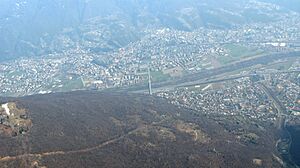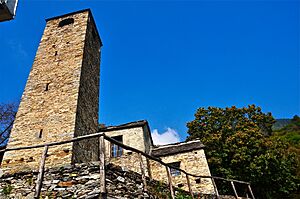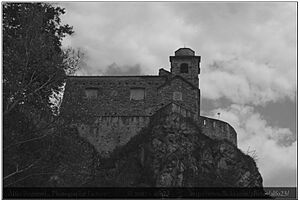Monte Carasso facts for kids
Quick facts for kids
Monte Carasso
|
||
|---|---|---|

Monte Carasso
|
||
|
||
| Country | Switzerland | |
| Canton | Ticino | |
| District | Bellinzona | |
| Area | ||
| • Total | 9.64 km2 (3.72 sq mi) | |
| Elevation | 237 m (778 ft) | |
| Population
(2004)
|
||
| • Total | 2,377 | |
| • Density | 246.58/km2 (638.6/sq mi) | |
| Postal code |
6513
|
|
| Surrounded by | Bellinzona, Cugnasco, Giubiasco, Gorduno, Preonzo, Sementina | |
Monte Carasso was once a small town, or municipality, located in the Bellinzona area of the canton of Ticino in Switzerland. It's known for its interesting history and unique architecture.
On April 2, 2017, Monte Carasso joined with several other nearby towns like Camorino, Claro, and Giubiasco to become part of the larger city of Bellinzona.
In 1993, the Swiss Heritage Society gave Monte Carasso the special Wakker Prize. This award recognized the town's efforts to keep its unique character and history alive, even as the bigger city of Bellinzona grew around it.
Contents
History of Monte Carasso
Monte Carasso was first mentioned in official records way back in 1348. For many centuries, its people had the right to send representatives to the Council of Bellinzona. This shows they had an important voice in the region.
Life in Early Monte Carasso
The people of Monte Carasso mainly lived in small groups on the mountain. From 1506, they had special rights to transport goods across the Ticino River. This was very important because the main bridge, called the Torretta Bridge, was destroyed in 1515 and wasn't rebuilt until 1815. So, the ferry was the only way to cross the river for a long time!
Churches and Religious Life
In 1634, the church in Monte Carasso became separate from the main church in Bellinzona. The main church, dedicated to Saints Bernardino and Jerome, was likely built in the late 1400s. It was built on the site of an even older Roman prayer place. This church was restored in 1905–06.
Another old church, San Bernardo, dates back to the 12th or 13th centuries. It has beautiful old frescoes (wall paintings) from the 1400s. The chapel of Madonna della Valle was built in the 1600s, and the Church of SS. Trinità was finished in 1655.
Work and Development
For hundreds of years, people in Monte Carasso earned their living mainly from farming and raising animals. In the mid-1800s, many residents moved overseas to find new opportunities.
To help people find jobs, especially refugees from Lombardy, special forts called the Fortini della fame (Forts of Hunger) were built in 1853.
Later, in the 1980s, the village underwent a big renovation project led by architect Luigi Snozzi. The first part of this project, from 1987 to 1993, involved restoring an old Augustinian convent. Today, this building is used as a primary school and a cultural center.
In 1998, a group called Fondazione Curzutt was created. Their goal is to bring life back to the old settlement on the Collina Alta, a high hill above Monte Carasso. By 2000, most workers in Monte Carasso had jobs outside the town.
Geography and Landscape

Monte Carasso covers an area of about 9.64 square kilometers (3.72 square miles). A large part of this area, about 61.3%, is covered by forests. About 8.4% is used for farming, and 6.8% has buildings or roads. The rest is rivers, lakes, or unproductive land like rocky areas.
The town is located in the Bellinzona district, on the right side of the Ticino River. It's part of the larger Bellinzona city area.
Coat of Arms
The blazon (description) of Monte Carasso's coat of arms is: a blue shield with a silver tower. Below the tower, there's a wavy blue bar on a silver base.
Population and People
Monte Carasso had a population of 2,377 people in 2004. By 2008, about 22.3% of the people living there were foreign nationals. Over ten years, from 1997 to 2007, the population grew by about 25.3%.
Languages Spoken
Most people in Monte Carasso speak Italian, which is about 90% of the population. German is the second most common language, spoken by about 3.5% of residents. A smaller number of people speak Portuguese (1.1%) or other languages.
Population Changes
In 2008, there were 26 babies born to Swiss citizens and 4 to non-Swiss citizens. In the same year, 7 Swiss citizens and 2 non-Swiss citizens passed away. The number of Swiss citizens increased by 19, and the foreign population increased by 2. Overall, the population grew by 1.7% in 2008.
Age Groups
In 2009, the population of Monte Carasso included:
- 10.9% children (0-9 years old)
- 10.2% teenagers (10-19 years old)
- 12.4% young adults (20-29 years old)
- 17.6% adults (30-39 years old)
- 17.0% adults (40-49 years old)
- 11.8% adults (50-59 years old)
- 10.1% seniors (60-69 years old)
- 6.0% seniors (70-79 years old)
- 4.0% seniors (over 80 years old)
Homes and Housing
In 2000, there were 932 households in Monte Carasso, with an average of 2.3 people per home. Most of the buildings were single-family homes (72.3%). There were also some two-family buildings and multi-family buildings.
The vacancy rate (empty homes) in 2008 was very low, at 0.72%. In 2000, there were 1,222 apartments. Most apartments had 4 rooms. About 76.3% of apartments were lived in all the time, while 23.3% were used seasonally (like vacation homes).
Historical Population Growth
Here's how the population of Monte Carasso has changed over time:
| year | population |
|---|---|
| 1591 | 709 |
| 1784 | 600 |
| 1801 | 496 |
| 1850 | 619 |
| 1900 | 956 |
| 1950 | 1,064 |
| 1990 | 1,610 |
| 2000 | 2,133 |
Important Heritage Sites
Several places in Monte Carasso are considered very important national heritage sites in Switzerland. These include:
- The Church of S. Bernardo, with its ancient frescoes.
- The Fortificazioni ottocentesche, also known as the Fortini della Fame (Forts of Hunger), which are shared with the nearby towns of Camarino and Sementina.
- The Church of SS. Trinità.
Wakker Prize Recognition
In 1993, the Swiss Heritage Society awarded Monte Carasso the Wakker Prize. This award celebrates towns that do a great job of preserving their unique look and feel. Monte Carasso was recognized for keeping its village center special and for restoring its old convent, which now serves as a school and cultural center.
Economy and Jobs
In 2007, Monte Carasso had an unemployment rate of 4.78%. Most people worked in the service industry (like shops or offices), followed by manufacturing and then farming.
In 2000, many people who lived in Monte Carasso worked in other towns (776 workers), while fewer people came into Monte Carasso for work (250 workers). This means more people left the town for jobs than came in. Most people used private cars to get to work (68.3%), while a smaller number used public transportation (6.7%).
As of 2009, there were 2 hotels in Monte Carasso.
Religion in Monte Carasso
According to the 2000 census, most people in Monte Carasso were Roman Catholic (82.0%). A smaller number belonged to the Swiss Reformed Church (3.3%). About 11.53% belonged to other churches, and 3.19% did not state their religion.
Unique Architecture
Monte Carasso, like many places in Ticino, has some interesting modern buildings. One example is the Albergo Möwenpick Benjamin and the Bellinzona-Sud motorway service area on highway A2. These were designed by architects Bruno Reichlin and Fabio Reinhart in 1989–1990. All the rooms in the hotel have a view of the Ticino River, and the building looks a bit like an old castle from the highway!
Education and Learning
In Monte Carasso, about 64.7% of adults (aged 25–64) have completed either high school or gone on to higher education like university.
Schools in Monte Carasso
In 2009, there were 422 students in Monte Carasso. The education system in Ticino includes:
- Kindergarten: Up to three years of non-mandatory kindergarten. In Monte Carasso, 75 children were in kindergarten.
- Primary School: This program lasts five years. 120 students attended standard primary schools, and 9 students attended a special school.
- Lower Secondary School: Students either go to a two-year middle school followed by a two-year pre-apprenticeship, or a four-year program to prepare for higher education. 110 students were in the middle school program, and 41 were in the advanced program.
- Upper Secondary School: This prepares students for a trade or for university. There were 18 full-time vocational students and 41 part-time vocational students.
- Professional Program: This three-year program prepares students for jobs in fields like engineering or nursing. 8 students were in this program.
In 2000, only 2 students came to Monte Carasso from other towns for school, while 217 residents went to schools outside the municipality.
Administration
Patrician Families
Some of the old and important families in Monte Carasso included: Morisoli, Monighetti, Grossi, Guidotti, Rambosio, Rossini, De Prati, Marcionetti, and Gioli.
See also
 In Spanish: Monte Carasso para niños
In Spanish: Monte Carasso para niños







